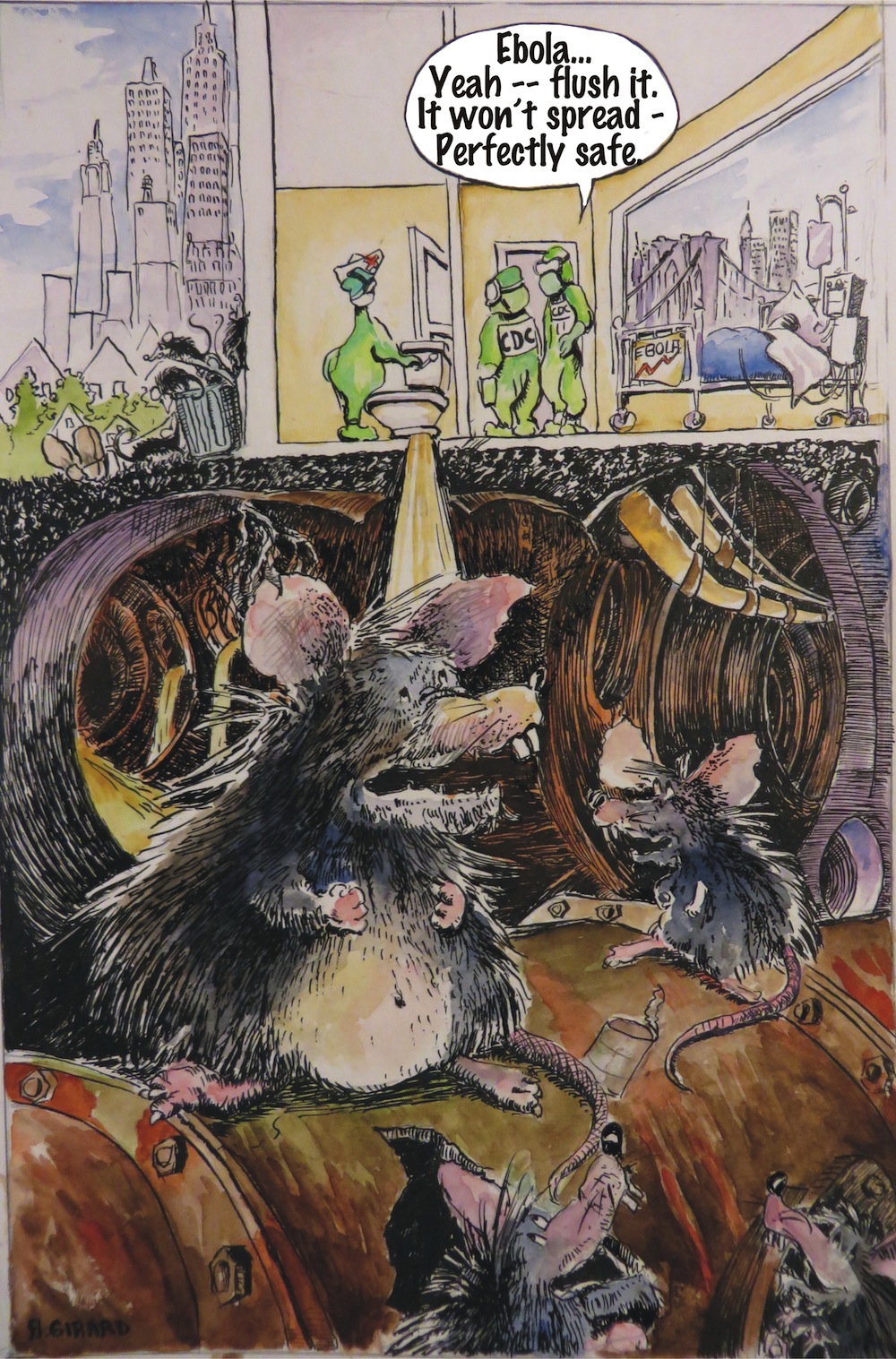Ebola: Are We Ready?
by Naja and Arnaud Girard
“What do you think? Of course we are preparing for the possibility of the Ebola virus.” That was Randy Detrick last Tuesday.
Detrick is the PR Director for Lower Keys Medical Center. What The Blue Paper wanted to know was whether our local hospital has the necessary isolation units and whether it is stocked with the full protective gear which could have saved Dallas hospital nurses Nina Pham and Amber Vinson from contracting the Ebola virus.
Detrick promised a written statement but has yet to answer our questions [aside from the usual ‘fear not good people, we are totally in control’ response cited above.]
What are the chances?
We were surprised to learn that Key West, by some strange twist of fate, has historically been a chosen point of entry for African-based disease.
It was 1981. The U.S. medical community was officially recognizing the existence of a mysterious epidemic caused by what would later be called the HIV virus; the AIDS epidemic. Epidemiologists would take years to retrace the path of the disease. They discovered that some of the 30,000 Cuban soldiers sent to support Agostinho Neto in the war in Angola had contracted the HIV virus in the jungle. Back home they began infecting both Cubans and Haitians. Then came the 1980 Mariel Boatlift. In just a few months, over 125,000 Cubans came ashore from Key West to Miami, many of them had been released, by order of Fidel Castro, from prisons and hospitals. Many were HIV positive. The Mariel boatlift has since been infamously credited for having precipitated the tragic impacts of the disease in the US. more here
Last Monday Raul Castro announced that Cuba is again highly engaged in Africa. Cuba has 4,000 medical workers in 32 countries in Africa who are being tasked with trying to control the [Ebola] outbreak.
Despite WHO’s [World Health Organization’s] praise for Cuba’s commitment to the fight against Ebola, the news is received with some ambivalence by South Florida’s well informed politicians.
“There are Cuban doctors that are being sent to West Africa. They are treating Ebola victims,” US Congresswoman Ileana Ros-Lehtinen told CBS Miami, “What will happen to those doctors? Some of them may be coming here.”
Critics of the Castro regime say Cuba’s altruism has to be taken with a grain of salt. A Deutch Welle report claims the Cuban government runs a $7.6 Billion a year business leasing the approximately 50,000 doctors and healthcare assistants working in over 66 countries. Brazil, for instance, pays about $ 4,000 US per month to the Cuban government for each of its borrowed doctors.
According to WHO, Cuba has recently sent over 300 doctors to West Africa to fight the epidemic, and the Cuban Government claims that another 15,000 ‘volunteers’ have also signed up for duty to fight Ebola [Deutch Welle report]
Ros-Lehtinen’s concern is that while we are focusing on the larger international airports, the threat could enter our region from southern points where protocols may not be as stringent.
According to Customs and Border Patrol [CBP], Border Patrol officers will isolate those “travelers with overt signs of communicable disease of public health significance.”
But do BP officers have the medical expertise to sort out the variety of symptoms that could be observed in a group of exhausted Cuban rafters? The most significant precursor of the disease is a simple elevated temperature.
If history was to repeat itself, some Cuban men and women, tired of being “volunteered” to the glory of communism, could come back from West Africa with the virus [Ebola virus has been found in men’s semen for up to three months after recovery] get in a raft and wash ashore with the deadly virus somewhere in Key West.
Is our hospital ready to isolate the problem?
LKMC has so far been mute as to its patient isolation capabilities, personal protective gear, and waste handling procedures.
The latter issue could be particularly controversial in the Florida Keys. It concerns the daily disposal of some 440 gallons of contaminated material resulting from the treatment of just one Ebola patient [including up to 2.5 gallons a day of extremely infectious bodily fluids.]
According to CDC [Center for Disease Control] Ebola waste handling guidelines, “sanitary sewer may be used for the safe disposal of Ebola patient waste.”
How safe is this process, however, in a town like Key West where an aging sewer system, compromised by saltwater, is suspected of leaking into storm water lines and into the ocean? [See The Blue Paper report HERE showing that the volume of raw sewage entering the local sewer treatment plant mysteriously triples following strong rain events even though the storm water and sewer lines are supposed to be completely separate, that sewer contamination peaks in the harbor immediately following rainfall but not in the neighboring basin where no storm water outfall is present, and finally data also showing considerable amounts of saltwater infiltration into raw sewer lines.)
In Atlanta, a local sewer company expressed concerns about that procedure. There was some back-tracking on a claim by an Emory Hospital doctor that the sewer company had threatened to cut off the hospital. Nonetheless, Emory Hospital settled the dispute by agreeing to pre-treat Ebola patients’ toilet waste before flushing it into the public sewer system.
Issues about the integrity of the sewer lines, as well as the safety of public works employees, plumbers, and sewer plant operators have been raised, yet the CDC’s guidelines have not been amended, “United States sanitary sewer system handling processes (e.g., anaerobic digestion, composting, disinfection),” explains the CDC, “are designed to safely inactivate infectious agents.”
Could sewer rats become infected with Ebola?
What could result from the flushing of Ebola infested sewage into the bowels of American cities? New York’s population of rats is estimated to outnumber the human population by a near 2:1 ratio. [16 Million rats compared to 8.4 Million people]
In fact, there are claims of a second “golden age” for sewer rats. They have infiltrated miles of sewer lines tapping into the endless food supply created by the garbage grinders installed in modern kitchens.
The epidemic that has now infected over 13,700 people in West Africa is caused by the “Zaire” strain of the Ebola virus. The live “reservoir host” for the virus has not yet been identified. However in 1999 researchers from the Pasteur Institute in Paris found evidence that not only are rodents able to contract Ebola, they could possibly be a host for the virus. The Pasteur scientists did not find any live virus in the rodents collected at ground level, but using molecular biology techniques they were able to find Ebola viral sequences in the apparently healthy rodents. “The study should help research toward finding the natural reservoir of the Ebola virus,” they stated at the time.
Studies of Lassa Fever are illustrative. In a bulletin by WHO professor Melissa Leach, Lassa Fever is described as a viral hemorrhagic fever [like Ebola]. Lassa Fever is spread via contact with the feces of infected rats.
In this context, couldn’t contamination of the rat population become part of an apocalyptic Ebola scenario? It is questionable whether the CDC protocol on sanitary waste disposal takes into consideration the obscure underworld that connects every home and business with a network of questionable pipelines containing raw sewage that has not yet made its way to a treatment plant for proper neutralization. According to the CDC website, even on hard surfaces, the Ebola virus can survive up to six days.
In spite of the CDC’s reassuring guidance, some state health departments, like Wisconsin’s, now “recommend pre-treatment of Ebola patient waste in a toilet bowl with one cup of bleach for at least five minutes prior to flushing.”
With only 90 miles separating us from Cuba, the country most involved with the epidemic in West Africa, shouldn’t we be taking all possible precautions? Whether or not we are is still unclear.
Stay tuned.
DID YOU LIKE THIS STORY? SUPPORT THE BLUE PAPER
Help us continue to bring you local investigative journalism… Click on the image to make a donation [NOT tax deductible].




